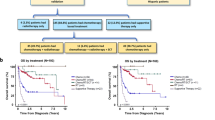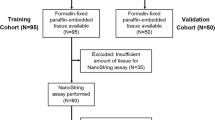Abstract
A novel nude mice model of human extranodal nasal type NK/T-cell lymphoma was established by subcutaneously implanting the sample taken from the patient with secondary extranodal nasal type NK/T-cell lymphoma of the stomach into the right axillary region of a BALB/c (nu/nu) nude mouse. This model had been successfully transplanted in vivo for thirty-two generations with a stable growth cycle. The survival rates of both resuscitation and transplantation were 100%. Histologically, the tumor cells were medium to large size and arranged in sheets, with a little mesenchyma, and disseminated almost in all passages of the lymphoma-bearing nude mice. Immunologically, the tumor cells were positive for CD56, cytoplasmic CD3, granzyme B or TIA-1 and LMP1, sometimes for CD8 but negative for surface CD3, CD7, CD20 and CD1a. EBER1/2 was found. No T-cell receptor γ gene rearrangement was detected in the transplanted tumors. Furthermore, both human sequencing-tagged sites SY14 and Y chromosome were detected by PCR or fluorescent in situ hybridization, respectively, in the transplanted tumor. The transplanted tumor in this novel nude mice model maintained the essential features of human extranodal nasal type NK/T-cell lymphoma, and it would be an ideal tool in vivo for further research of the tumor.
This is a preview of subscription content, access via your institution
Access options
Subscribe to this journal
Receive 12 print issues and online access
$259.00 per year
only $21.58 per issue
Buy this article
- Purchase on Springer Link
- Instant access to full article PDF
Prices may be subject to local taxes which are calculated during checkout







Similar content being viewed by others

References
Jaffe ES, Harris NL, Stein H, Vardiman JW . World Health Organization Classification of Tumors. Pathology and Genetics of Tumors of Haematopoietic and Lymphoid Tissues. IARC press: Lyon, 2001, pp 204–247.
Jaffe ES, Chen JKC, Su IJ, Glauco F, Shigeo M, Feller AC et al. Report of the workshop on nasal and related extranodal angiocentric T/NK cell lymphomas: definition, differential diagnosis, epidemiology. Am J Surg Pathol 1996; 20: 103–111.
Jaffe ES, Krenacs L, Kumar S, Kingma DW, Raffeld M . Extranodal peripheral T cell and NK cell neoplasms. Am J Clin Pathol 1999; 111 (Suppl 1): S46–S55.
Chiang AKS, Chan ACL, Srivastava G, Ho FCS . Nasal T/natural killer(NK)-cell lymphomas derived from Epstein-Barr virus-infected cytotoxic lymphocytes of both NK- and T-cell lineage. Int J Cancer 1997; 73: 332–338.
Weiping L, Gandi L, Yonghui L, Chuanyu L . Nasal NK/T cell lymphoma—Report of 15 years research. Lin Chuang Yu Shi Yan Bing Li Xue Za zhi 2000; 16: 89–92.
Qionglan T, Weiping L, Gandi L, Chuanyu L, Yonghui L, Huan X et al. Follow-up observation of 140 upper-respiration tract NK/T cell lymphomas. Zhong Hua Er Bi Yan Hou Ke Xue Za zhi 2002; 37: 393–394.
Kagami Y, Nakamara S, Suzuki R, IiDA S, Yatabe Y, Okada Y et al. Establishment of an IL-2-dependent cell line derived from ‘nasal-type’ NK/T-cell lymphoma of CD2+, SCD3-, CD3ɛ+, CD56+ phenotype and associated with the Epstein-Barr virus. Br J Haematol 1998; 103: 669–677.
Tsuchiyama J, Yoshino T, Mori M, Kondoh E, Oka T, Akagi T et al. Characterization of a novel human natural killer cell line (NK-YS) established from natural killer cell lymphoma/leukemia associated with Epstein-Barr virus infection. Blood 1998; 92: 1374–1383.
Nagata H, Konno A, Kimura N, Zhang Y, Kimura M, Demachi A et al. Characterization of a novel human natural killer (NK)-cell and γδ T cell lines established from primary lesions of nasal-cell lymphomas associated with the Epstein-Barr virus. Blood 2001; 97: 708–713.
Lin YW, Nichols RA, Letterio JJ, Aplan PD . Notch1 mutations are important for leukemic transformation in murine models of precursor-T leukemia/lymphoma. Blood 2006; 107: 2540–2543.
Rashidi B, Jiang P, Jiang P . A nude mouse model of massive liver and lymph node metastasis of human colon cancer. Anticancer Res 2000; 20: 715–722.
Wistuba II, Behrens C, Milchgrub S, Syed S, Ahmadian M, Virmani AK et al. Comparison of features of human lung cancer cell lines and their corresponding tumors. Clin Cancer Res 1999; 5: 991–1000.
Denyssevych T, Lestou VS, Knesevich S, Robichaud M, Salski C, Tan R et al. Establishment and comprehensive analysis of a new human transformed follicular lymphoma B cell line, Tat-1. Leukemia 2002; 16: 276–283.
Wistuba II, Behrens C, Milchgrub S, Syed S, Ahmadian M, Virmani AK et al. Comparison of features of human breast cancer cell lines and their corresponding tumors. Clin Cancer Res 1998; 4: 2931–2932.
Yagita M, Huang CL, Umehara H, Matsuo Y, Tabata R, Miyake M et al. A novel natural killer cell line (KHYG-1) from a patient with aggressive natural killer cell leukemia carrying a p53 point mutation. Leukemia 2000; 14: 922–930.
Lovejoy EA, Clarke AR, Harrison DJ . Animal models and the molecular pathology of cancer. J. Pathol 1997; 181: 130–135.
Kubota T . Metastatic models of human cancer xenografted in the nude mouse: the importance of orthotropic transplantation. J Cell Biochem 1994; 56: 4–8.
Bernard N, Devevey L, Jacquemont C, Chrétien P, Helissey P, Guillosson JJ et al. A new model of pre-B acute lymphoblastic leukemia chemically induced in rats. Exp Hematol 2005; 33: 1130–1139.
Schlade-Bartusiak K, Sasiadek MM, Bar JK, Urbschat S, Blin N, Montenarh M et al. Cytogenetic and molecular cytogenetic characterization of the stable ovarian carcinoma cell line (OvBH-1). Cancer Genet Cytogenet 2006; 164: 10–15.
Urzua U, Frankenberger C, Gangi L, Mayer S, Burkett S, Munroe DJ . Microarray comparative genomic hybridization profile of a murine model for epithelial ovarian cancer reveals genomic imbalances resembling human ovarian carcinomas. Tumour Biol 2005; 26: 236–244.
Williams SV, Adams J, Coulter J, Summersgill BM, Shipley J, Knowles MA . Assessment by M-FISH of karyotypic complexity and cytogenetic evolution in bladder cancer in vitro. Genes Chromosomes Cancer 2005; 43: 315–328.
Han JY, Goh RY, Seo SY, Hwang TH, Kwon HC, Kim SH et al. Cotransplantation of cord blood hematopoietic stem cells and culture-expanded and GM-CSF-/SCF-transfected mesenchymal stem cells in SCID mice. J Korean Med Sci 2007; 22: 242–247.
Abraham EJ, Kodama S, Lin JC, Ubeda M, Faustman DL, Habener JF . Human pancreatic islet-derived progenitor cell engraftment in immunocompetent mice. Am J Pathol 2004; 164: 817–830.
Yoon YS, Wecker A, Heyd L, Park JS, Tkebuchava T, Kusano K et al. Clonally expanded novel multipotent stem cells from human bone marrow regenerate myocardium after myocardial infarction. J Clin Invest 2005; 115: 326–338.
Allen RJ, Smith SD, Moldwin RL, Lu MM, Giordano L, Vignon C et al. Establishment and characterization of a megakaryoblast cell line with amplification of MLL. Leukemia 1998; 12: 1119–1127.
Acknowledgements
We wish to thank Professor Norio Shimizu (Department of Virology, Tokyo Medical and Dental University, Japan) and Dr Yu Zhang (First Department of Internal Medicine, Tokyo Medical University, Japan) for providing us with human extranodal nasal type NK/T-cell lymphoma cell line, SNK6. This work was supported by National Natural Science Foundation of China (30470747 and 30570769).
Author information
Authors and Affiliations
Corresponding author
Additional information
Supplementary Information accompanies the paper on the Leukemia website (http://www.nature.com/leu)
Supplementary information
Rights and permissions
About this article
Cite this article
Zhao, S., Tang, Q., He, M. et al. A novel nude mice model of human extranodal nasal type NK/T-cell lymphoma. Leukemia 22, 170–178 (2008). https://doi.org/10.1038/sj.leu.2404945
Received:
Accepted:
Published:
Issue Date:
DOI: https://doi.org/10.1038/sj.leu.2404945


